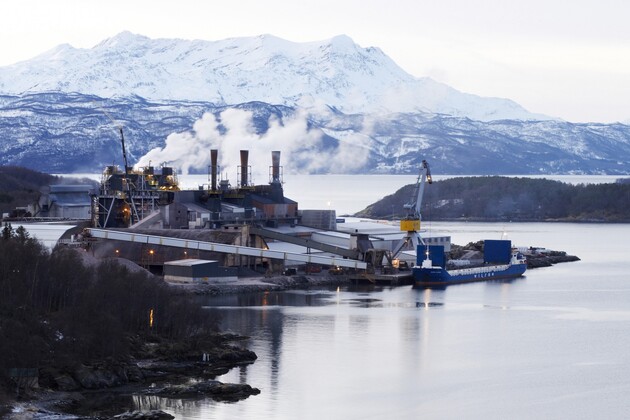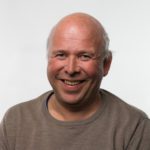Scientists create healthy salmon feed from polluting CO₂

Polluting CO₂ is turned into nutritious feed for farmed salmon. Science fiction? Absolutely not. All it takes are three innovative research environments, a visionary actor in the heavy metal industry, and large quantities of microalgae.
An emission of 300,000 tonnes of CO₂ annually at Finnfjord AS, a ferrosilicon producer located in Northern Norway, is captured in microalgae. The algae use carbon dioxide (CO₂) as an energy source. You could say the algae “eat” CO₂ – just as plants on land do.
Nofima produce the feed that includes the algae:
“We incorporate the algae into the feed and conduct growth trials with the salmon, from fry to slaughter weight. It is technically challenging, but results so far show that the salmon grow well on the algae feed and are in good health,” says senior scientist Sten Siikavuopio, who leads Nofima’s part of the project.
The goal of Finnfjord AS is zero emissions – and to utilise all the CO₂ generated by the plant.
The aim of turning CO₂ into food for diatoms – which in turn become valuable ingredients in salmon feed – is being pursued by UiT – The Arctic University of Norway, SINTEF, and Nofima in collaboration with Finnfjord AS.
Diatoms are very rich in fatty acids
One of the major challenges in the global aquaculture industry has been sourcing enough marine oils for salmon feed. At the very bottom of the food chain, scientists are now finding the most promising new ingredients for farmed fish feed, including microalgae. The algae are very rich in omega-3 fatty acids such as DHA and EPA, which salmon need in their diet.
“Microalgae can grow quickly and produce more of the healthy omega-3 fatty acids when cultivated in large reactors at Finnfjord AS. This makes them particularly interesting as a feed ingredient,” says Sten Siikavuopio.
He believes algae oil has qualities that mean it could replace fish oil in fish feed.
The research project AlgOpti at Finnfjord AS received NOK 93.3 million in 2021 from the Green Platform, a funding scheme for new sustainable technology and green solutions, to develop salmon feed using CO₂. The project will also establish methods for cultivating useful algae. Out of this, the project Mikro-fôr – Microalgae as a feed raw material for farmed fish – was born. This project is funded by FHF – The Norwegian Seafood Research Fund and led by SINTEF Ocean.
“Previous tests where diatoms were added to standard salmon feed have demonstrated that the salmon have maintained good health throughout their life cycle on such feed. But the maximum addition of algae in feed so far has only been three percent. We need to find out how much algae can be added to the feed,” Siikavuopio states.
One reason for the low proportion of algae in the feed until now has been issues with water in processed algae biomass, but improved technology has now made it possible to add more algae to the feed.
“With the new feed we have tested, we have managed to include up to 15 percent algae in the feed. Trials so far show that the fish grow and thrive very well with a high inclusion of algae in the feed,” says Sten Siikavuopio.
Carefully developed recipe
The process of finding a system that makes the emissions of polluting substances CO₂ and NOx from ferrosilicon production available to the algae has been developed by Finnfjord AS and UiT – The Arctic University of Norway. The collaboration between UiT and Finnfjord involves cultivating algae in large tanks placed at the smelter.
The algae are grown in large tanks. Carbon dioxide – the exhaust – from ferrosilicon production is channelled into the tanks, and the algae produce protein and valuable marine oil.
The algae biomass is then sent to feed producers at Nofima, Skretting, and Cargill, who, using a carefully developed recipe – a detailed formula – develop the feed containing algae biomass.
The specially developed feed is now being tested in salmon production. In addition to good growth and health, scientists and fish farmers can note yet another highly positive side effect of the algae feed:
“Microalgae in the feed also result in less salmon lice infection. This has been documented,” states Sten Siikavuopio.
Interdisciplinarity at its best
He works in the production biology department at Nofima. However, several departments at the institute are involved in the research project:
It is colleagues at Nofima’s feed technology centre that Sten Siikavuopio has worked with to develop the feed recipe. And quality scientist Stein Harris Olsen and fish health scientist Elisabeth Ytteborg have led the work to document the quality and fish health of salmon that have eaten the algae feed:
– Is the fish edible? The answer is an unequivocal yes.
– Is the muscle in salmon fed with CO₂-consuming algae different from other salmon? The answer is no.
– Is the salmon in good health? Again, the answer is yes.

Photo: Anne-May Johansen, Nofima
In addition, the project involves several students from UiT, supervised by Professor Edel Elvevoll.
“Comprehensive and dynamic are the keywords here. Interdisciplinarity at Nofima is at its very best in projects like this,” the senior scientist asserts.
To date, only a tiny fraction of the world’s many microalgae species have been considered as potential feed for aquaculture.
“There will likely be more work testing different types of algae and optimising the processes both for cultivating the algae and using the marine oil in fish feed,” says Sten Siikavuopio.
Facts about Finnfjord AS
Finnfjord is one of the world’s most energy-efficient and environmentally friendly producers of ferrosilicon – a raw material used, among other things, in the steel industry. The goal is to become the world’s first CO₂-free ferrosilicon producer.
Finnfjord AS has three furnaces with a production capacity of 100,000 tonnes of ferrosilicon per year.
In 2012, a thermal energy recovery plant was installed at Finnfjord AS. A steam turbine produces 340 GWh of electricity.
The energy recovery plant helps make Finnfjord AS one of the world’s most environmentally friendly producers of ferrosilicon.
In 2014, Finnfjord AS entered into a collaboration with UiT to use algae to reduce the company’s CO₂ emissions.
Contact person
Research areas
Feed development and nutrition
Topics
Low trophic species
Research facilities
